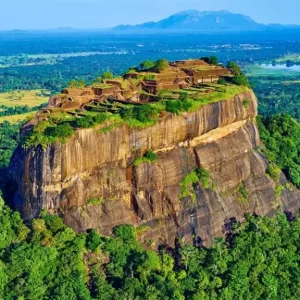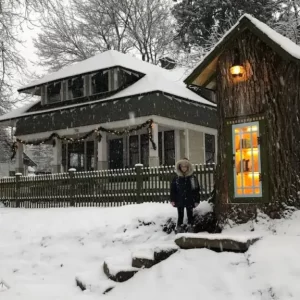There are many other places in the country that are worth seeing, however. Some are reasonably accessible while others are only for those who are prepared to spend the necessary time and effort to get to places where transport and other facilities can be poor.
If you have already covered the main sights, I recommend considering some of the places covered in this chapter. Some have only recently opened to foreign visitors but hopefully as tourism develops, the potential problems will reduce and more visitors will discover these areas.
Pyay
This is an appropriate stop midway between Yangon and Bagan. The town is quite uninspiring except for the stunning Shwesandaw Pagoda and the nearby big seated Buddha – the reason to stop is for the ancient Pyu city of Sri Kestra. Although it’s not nearly as impressive as Bagan, it’s likely to be Myanmar’s first site on the UNESCO World Heritage List.
About 8 km east of Pyay, near Hanlin village, archaeologists have found large, low sections of brickworks that once formed part of a wall enclosing a large complex, dating back to the Pyu era (4th to 9th centuries AD).
There are many excavation sites scattered over many miles and some have yielded pottery and coins from various eras. Several excavated grave sites can be visited where you can still see the ornaments and weapons with which the bodies were buried.
The Pyxis built large cities enclosed by walls. Each city is located at the center of a network of irrigation channels, connected to the local rivers. Sri Kestra, the largest Pyu city, was enclosed by a circular brick city wall with a diameter of 4.4 km. It contains several brick monuments (stupas and temples).
Hanlin village is a magical place in its own right. Unpaved ox-cart tracks link an incredible plethora of decaying old stupas that create the feeling of an untouched mini-Bagan. This is best appreciated when the scene is viewed from behind Maung San Monastery with its obvious golden zedi.
Near the market is a collection of inscribed steles and stone slabs in the now-forgotten Pyu script. Within the Nyaung Kobe Monastery, a museum room displays various ancient, but unlabelled, archaeological finds. Another minor attraction is the little hot spring area where villagers collect water from circular concrete-sided well-pools and bathe in two bigger basin-pools.
Some people will enjoy visiting Shwedaung, about 15 km south of Pyay to see the large sitting Buddha wearing a huge set of gold-rimmed eyeglasses at the Shwe Myetman Pagoda. It is said that this image can cure eye problems.
Western Myanmar
Only open to visitors since the 1990s, western Myanmar covering the area of Rakhaing and Chin States is still very much off the beaten track. It’s an extensive region of sandy beaches, slow-moving rivers, jungle and impenetrable hills isolated from central Myanmar by a series of mountain ranges.
To the southwest, the region fronts the Indian Ocean, then further north it borders Bangladesh and the Indian states of Mizoram and Manipur. This area has been neither fully Burmese nor Indian over the years.
The Kingdom of Arakan once flourished here; a Buddhist State where the kings also had a Muslim title. You can fly into the area to Kyaukphyu and to Sittwe, both of which are on the coast. Inland is tough country with roads few and far between. This region has seen extensive ethnic disturbances since 2013 which are often led by nationalistic Buddhist monks, so you are advised to seek advice before venturing too far.
The problem concerns the one million or so Rohingya Muslims who are not recognized by the Myanmar government and are thus stateless, but who continue to live in Rakhine and Chin States despite animosity from the remaining population.
Ngapali
This is Myanmar’s best beach resort. It is situated 10 km southwest of Thandwe in the south of Rakhaing. The only practical access is via Thandwe airport which is served by four local airlines. The alternative is a 16-hour bus trip.
There are three main beaches, all facing west and the tranquil, palm-lined bays have soft, white sand, translucent water and wonderful seafood. Most visitors stay in a string of small 4-star hotels dotted along the shore. There is a giant golden Buddha on a hilltop at the very south end of the beach.
Fishermen from the nearby villages well outnumber tourists on parts of the beach, and their boats still bob around offshore unworried by tourist power craft. All that looks set to change, however, as building continues and a tourism bonanza is expected. A present, south of the hotels, is the fishing village of Jate Taw (Gyeik Taw), which offers a slice of local life.
Snorkeling and fishing trips, cycling and golf on the 18-hole course between the main beach resorts and the airport, offer alternatives to lounging on the sand in one of the small bars dotted along the bay. You can rent a bicycle (around K2000/half day) or a motorbike (around K3000/hour).
The Oriental Ballooning Company started flying hot air balloons over Ngapali beach for the first time in November 2015 and they plan to continue until March or April 2016. This adds a further dimension to a Ngapali experience.
There are beach restaurants owned by local fishermen in two designated beach areas. Smoke billows from the open-air grills where fish are cooked by leathery men in beaten-up hats.
This is a place to encounter seaside perfection and its great to have to share it with so few people. There are no nightclubs, no discos, and no motorized motorsports, yet. Many properties only operate for about half the year.
Tanintharyi (Tenasserim) region
Still more isolated is the exquisite coast of Tanintharyi (Tenasserim) region, in the far south, which is slowly opening up to foreign travelers. At present, the entire region is a delightful tropical backwater, perhaps fifty years removed from the relative affluence and openness of neighboring Thailand. A more pristine, more beautiful part of mainland southeast Asia would be hard to find.
The Myeik Archipelago consists of around 800 coral-fringed islands scattered off the coast. It is a tropical paradise of the kind that has all but disappeared in southeast Asia. The archipelago offers great opportunities for exploration and diving amongst spectacular marine life and untouched coral reefs
Most visitors fly into Kawthaung airport then transfer to a cruise boat. November to April is the high season for visiting the Myeik Archipelago with December to February offering the best weather conditions.
The previous ban on independent travel imposed by the government for many years has ensured that the islands remain much as they have for centuries, inhabited by communities of Malay fishermen and semi-nomadic “Sea Gypsies” who spend the dry season on small boats and return to ramshackle villages on land during the monsoons.
The islands offer a wide variety of sights and adventurous activities, from hiking through tropical valleys to kayaking through mangroves and up rivers and walking on hundreds of deserted white sand beaches. One of the most renowned dive sites in Southeast Asia, the huge Burma Banks are located on the west side of the archipelago, where the continental shelf drops off into the deep sea beyond.
Tourism has thus far made negligible impact. You can check into the incongruous, Andaman Club on Thahtay Kyun Island – a 205-room five-star with its own 18-hole golf course and Vegas-style casino or alternatively the Myanmar Andaman Resort on Fork (Macleod) Island which consists of around 24 small wooden houses sprinkled along the sea front, with dining area, bar and offices at the centre.
A handful of Thai boats, working out of Phuket, run live-aboard cruises to the world-class dive sites in the area.


